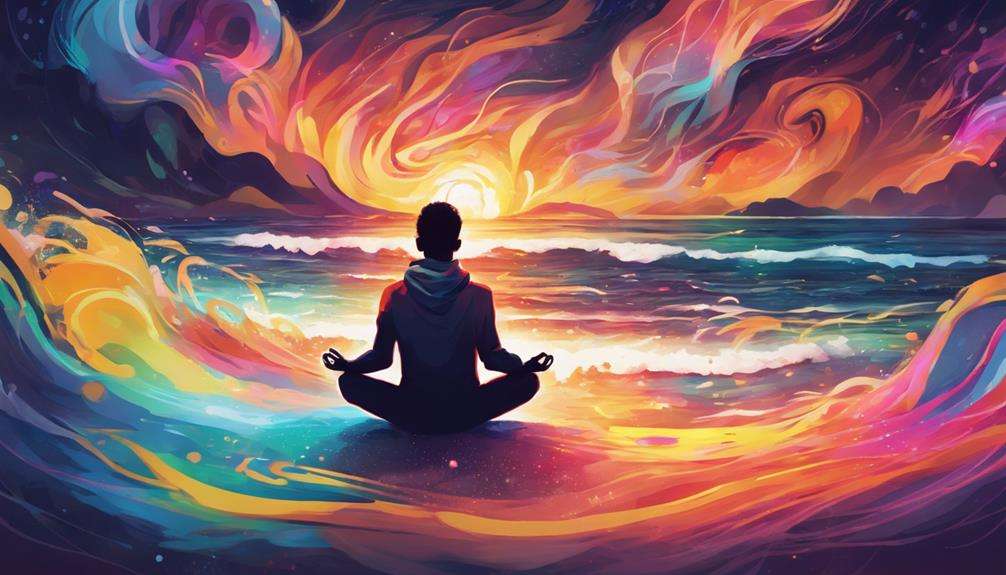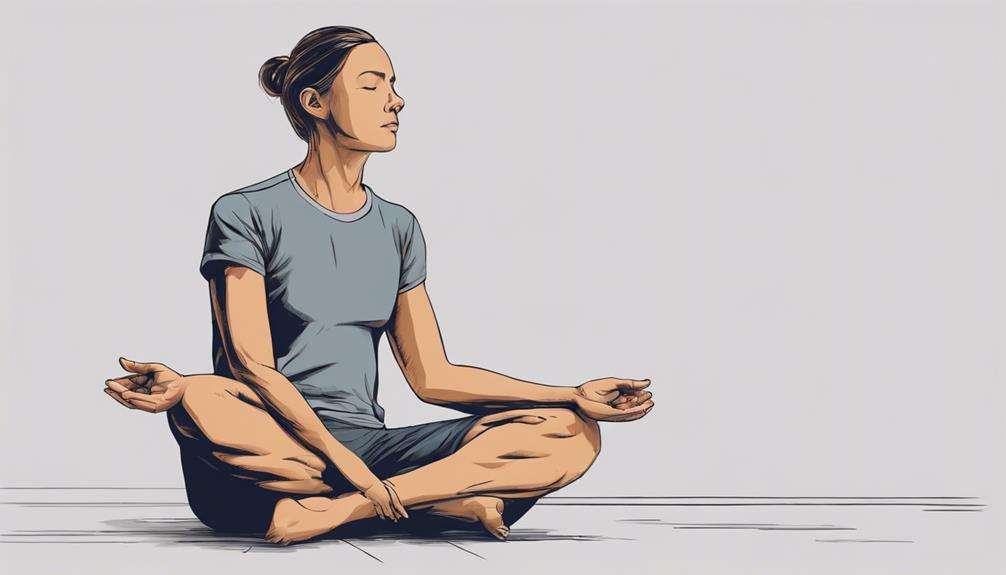If you've ever struggled with traditional meditation techniques, visualization meditation for relaxation might be the perfect alternative for you. By tapping into the power of your mind's eye, you can transport yourself to calming and soothing landscapes without needing to sit in silence for extended periods.
But have you ever wondered how exactly visualization meditation works and what benefits it can offer beyond just relaxation? Let's explore the intricacies of this practice and uncover the secrets behind its effectiveness in promoting mental well-being and inner peace.
Key Takeaways
- Visualization meditation promotes relaxation through guided imagery and positive mental visualization.
- It aids in reducing stress, anxiety, and enhancing emotional well-being.
- Techniques like safe place visualization and loving-kindness meditation foster mental clarity.
- Visualization meditation cultivates calmness, tranquility, and emotional balance for overall well-being.
Understanding Visualization Meditation
What makes visualization meditation a powerful practice for promoting relaxation and mindfulness?
Visualization meditation involves focusing on mental images to enhance relaxation and mindfulness. By incorporating guided imagery, this practice creates a serene and tranquil experience. During visualization meditation, individuals visualize peaceful scenes, personal aspirations, or positive emotions, allowing them to immerse themselves in a calming mental space. This technique is known to reduce stress, anxiety, and enhance emotional well-being by promoting a sense of inner peace and tranquility.
Moreover, visualization meditation serves as a valuable tool for fostering creativity, self-confidence, and overall mental well-being. By engaging in this practice regularly, individuals can tap into their creative potential, boost self-assurance, and cultivate a positive mindset. Through visualization, one can visualize success, overcome challenges, and manifest their desired outcomes, thereby supporting their emotional and mental wellness.
Embrace visualization meditation to reveal its full potential for relaxation, mindfulness, and personal growth.
Benefits of Visualization for Relaxation
Utilizing visualization techniques for relaxation can substantially contribute to calming your mind and reducing stress levels. Visualization meditation helps release tension from the body, leading to a state of deep relaxation. By incorporating visualization techniques into your relaxation routine, you can experience stress relief, improved mental health, and enhanced overall well-being. This practice not only aids in reducing stress but also cultivates positive feelings, allowing you to achieve emotional balance and inner peace.
One of the significant benefits of visualization meditation is its ability to enhance mental well-being by promoting a sense of calmness and tranquility. Additionally, practicing visualization techniques for relaxation can have a positive impact on sleep quality, helping to reduce insomnia and improve your overall sleep patterns. By incorporating visualization into your daily routine, you can experience the numerous benefits of meditation and enjoy a more relaxed and balanced state of mind.
Techniques for Visualization Meditation

As you explore the domain of relaxation through visualization meditation, various techniques can serve as powerful tools to center your mind and enhance your well-being.
Here are some techniques that you can incorporate into your practice:
- Safe Place Visualization: Imagine a peaceful and secure location where you feel calm and content, allowing yourself to immerse in the sensations of safety and relaxation.
- Color Breathing: Visualize inhaling and exhaling colored light to evoke specific emotions or feelings, using the power of colors to promote relaxation and balance.
- Loving-Kindness Meditation: Foster feelings of compassion and goodwill towards yourself and others through this practice, cultivating a sense of interconnectedness and positivity.
These techniques, including guided imagery, positive statements, and mental imagery, can help you focus your mind, reduce stress, improve your mood, and enhance your overall well-being.
Incorporating these visualization meditation practices into your routine can lead to profound relaxation and stress relief.
Visualization Meditation Exercises
Ready to enhance your visualization meditation practice?
Start by picturing peaceful scenes or setting personal goals to deepen your experience.
Combine visualization with affirmations or guided imagery for a more profound sense of relaxation and stress relief.
Benefits of Visualization
Visualization meditation exercises offer a powerful tool for promoting relaxation through the cultivation of positive mental images. By engaging in visualization techniques, you can experience various benefits that contribute to your overall well-being:
- Reducing stress, anxiety, and insomnia
- Enhancing creativity and boosting self-image
- Visualizing peaceful scenes, goals, and positive emotions
These exercises not only help in achieving a relaxed state but also aid in improving your mental clarity and emotional balance. Whether you focus on visualizing a safe place, practicing color breathing, or picturing your aspirations, visualization meditation can be a valuable practice for promoting relaxation and inner peace.
Techniques for Relaxation
To explore effective techniques for relaxation through visualization meditation exercises, consider incorporating practices such as safe place visualization, color breathing, and loving-kindness meditation. Safe place visualization involves imagining a calming and secure location to retreat to in times of stress.
Color breathing entails envisioning inhaling a soothing color and exhaling any tension or negativity. Loving-kindness meditation focuses on sending compassion and goodwill to oneself and others.
Guided imagery with affirmations can enhance relaxation by combining positive statements with mental images. Candle flame meditation aids relaxation by focusing on a flickering flame.
Body scan meditation promotes relaxation by bringing awareness to different body parts, releasing tension. Incorporating these techniques into your visualization meditation practice can help foster a sense of calm and relaxation.
Tips for Effective Visualization Practice

To enhance your visualization practice, focus on using a meditative anchor like your breath.
Maintain a proper posture, such as the mountain posture, to support effective visualization meditation.
Remember to breathe naturally, avoiding force, to cultivate a relaxed state during visualization sessions.
Techniques for Visualization
For effective practice in visualization techniques, incorporating color breathing, loving-kindness meditation, and guided imagery can greatly enhance your relaxation and goal achievement experiences.
- Color Breathing: Visualize inhaling calming colors like blue or green, and exhaling stress and tension in darker shades.
- Loving-Kindness Meditation: Picture sending love and kindness to yourself and others, fostering positive emotions and reducing negative ones.
- Guided Imagery: Follow a script or recording that takes you through relaxing scenes or helps you visualize achieving your goals.
Benefits of Visualization
Enhancing your visualization practice can lead to a myriad of benefits, including increased creativity, confidence, and improved self-image. Through visualization meditation, you can effectively reduce stress, anxiety, and insomnia, ultimately enhancing your mental well-being.
By picturing serene settings and visualizing yourself achieving personal goals, you can experience positive emotional shifts. The brain responds similarly to actual experiences and visualizations, making it a powerful tool for personal growth and self-improvement.
Consistent practice of visualization exercises can yield better results in relaxation and mindfulness, allowing you to tap into the full potential of this technique for enhancing your overall well-being. Start incorporating visualization into your daily routine to reap these benefits and cultivate a more positive mindset.
Common Pitfalls to Avoid
As you start on your visualization practice, being mindful of common pitfalls can greatly enhance the effectiveness of your sessions. To help you make the most out of your practice, consider the following tips:
- Avoid rushing: Take your time to help you achieve deep relaxation and focus.
- Stay open to adjustments: If your visualization doesn't feel right initially, be willing to make changes.
- Minimize distractions: Keep a clear mental image by reducing external disturbances.
Common Questions About Visualization Meditation

Exploring common inquiries about visualization meditation can deepen your understanding of this relaxation technique. Visualization meditation involves combining meditation with mental imagery to promote relaxation, stress reduction, and mindfulness. It allows you to visualize peaceful scenes, personal goals, and positive emotions, which can positively impact your mind and body.
Some common questions that may arise include how visualization meditation benefits your overall well-being, how it influences your feelings during and after the practice, and how to effectively use mental imagery to achieve relaxation. Understanding that there's no right or wrong way to practice visualization meditation can alleviate concerns about doing it correctly.
Frequently Asked Questions
What Is Visualization Relaxation Technique?
When you ask about the visualization relaxation technique, it's about tapping into calming mental images. It's a way to reduce stress, anxiety, and find peace. Using guided imagery and creative visualization helps in relaxation and stress relief.
Does Visualisation Meditation Work?
Visualization meditation works by engaging your mind and senses to create a calming mental image. Science supports its effectiveness for reducing stress and improving well-being. Personal experiences often reflect benefits like enhanced relaxation, positivity, and improved sleep.
What Is Visualization Meditation Called?
When practicing visualization meditation, you engage in guided imagery. This technique utilizes creative visualization and mental imagery for relaxation. It helps you connect your mind and body, fostering inner peace and stress relief through healing visualization and visualization techniques.
What Is the Difference Between Visualization Meditation and Mindfulness Meditation?
In visualization meditation, you focus on mental imagery for relaxation. Mindfulness meditation centers on being present in the moment. Visualization uses creative imagery, while mindfulness emphasizes awareness. Both offer stress relief and inner peace.
Conclusion
To sum up, visualization meditation for relaxation is a powerful practice that can help you calm your mind, reduce stress, and promote a sense of peace. As the saying goes, 'A picture is worth a thousand words,' and by visualizing serene scenes or positive outcomes, you can enhance your overall well-being.
Incorporating visualization meditation into your daily routine can lead to improved mental health and emotional well-being. Give it a try and experience the benefits for yourself.






